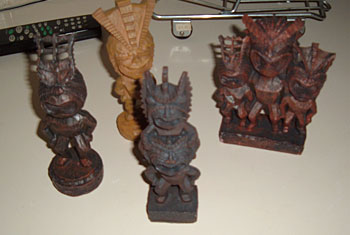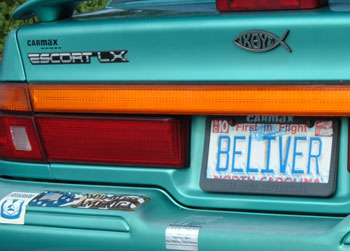I am homosexual. I am not gay. There is a difference.
I have sexual relations exclusively with men. The means that I am homosexual. That is all it means. This fact does not have any implications with respect to my politics nor my taste in music or fashion or literature. None. The fact that I have sexual relations with men does not say anything about me other than that I have sexual relations with men. Sexual orientation is about sex. Only. Period.
My lifestyle can beat up your lifestyle:
Many homosexual people also consider themselves to be gay. “Gay” is not a sexual orientation. “Gay” is a lifestyle and a collection of cultural, social, and political values that some homosexuals (and no doubt some non-homosexuals) share, most of which are not inherently related to sexual orientation. The fact that I have sex with members of my same sex does not mean that I am predisposed toward any certain set of non-sexual behaviors.
There are those who believe my last statement suggests that all homosexuals are nothing more than one-dimensional sexual beings. Actually, the opposite is true. My sexual orientation is only a small part of my life. I am not a one-dimensional individual. I have many and varied interests. However, the mere fact that I am homosexual does not mean that I am naturally inclined toward certain dance music or TV shows or fashions any more than being a carnivore might make me enjoy bullfights or being black would make me crave watermelon. There’s just no connection.
In fact, it is those people who allow their sexual orientation to dictate the everyday, non-sexual aspects of their lives who really seem one-dimensional to me. People who read only “gay books”, see only “gay movies”, and listen only to “gay music” hold no real appeal for me. As someone who values individuality and the ability to think for myself, a culture of lifestyle fashion victims being spoon-fed a very specific package of jargon and merchandising holds very little appeal.
Despite what I’ve said in the past, I now agree that there is a “gay community”. I just question whether the majority of homosexuals actually choose to be members of it.
A bill of goods:
Sexual orientation is a morally, socially, and politically neutral factor. The mere fact that I prefer to suck dick does not make me inherently morally superior to anyone else, nor does it make me inherently inferior. It also does not infuse me with a specific set of values common to all homosexuals. While it may well shape my opinions of political issues specifically related to my sexual orientation, even this is not a given.
The fact that I suck dick does not mean that I support every fuzzy left cause that surfaces, any more than preferrring women would automatically make me a member of the fanatical right. This assumption really irritates me, even when it’s a fuzzy left cause that I do support. It’s insulting. All homos don’t think alike. What, actually, do nuclear power or the rainforest or subsidized housing for the homeless really have to do with one’s sexual orientation? While I do have very specific opinions on these issues, they are centered in my brain, not my testicles.
Entitle this:
I call it “Gay Entitlement Syndrome”: the erroneous assumption that people should go out of the way to shop “within the community”. It’s pure and simple guilt-based marketing, nothing but a solicitation for charitable contributions, and it’s no way to run a business. My custom must be earned; I make my purchases with the company that most matches my needs and offers the best value and quality for my money. I do not owe anyone my business merely because we share a sexual orientation, and any business that assumes I do will have to get by without my patronage. I will not be taken for granted.
An example: when I used to drink, I found that I often preferred doing so socially in “non-gay” bars. The beer selection was invariably better and usually cheaper, I was actually able to have conversations with my friends, and I wasn’t faced with horrible, annoying dance music that all gay people may like, but that some homosexuals really hate.
On the other hand, bars serving my “community” were essentially useless for any purpose other than for picking up guys — and they were often somewhat lacking on that front as well. However, “gay bars” were all in all a better option for meeting sex partners, so that’s what I used them for.
If a bookstore or bar owned by a homosexual best meets my needs, I’ll gladly patronize it. If it doesn’t, I’ll go somewhere else. Simple, huh?
The protective homo cone of self-righteousness:
Socially and culturally, everything still comes down to personal choice and responsibility. And homosexuality does not, and will not, free one of personal responsibility for the choices one makes, nor is it an excuse for inferior quality work nor for the abandonemnt of critical thinking skills.
Homosexuals commit bad writing, thievery, murder, stupidity, and any number of other capital offenses in approximately the same proportion as anyone else, and they should be punished, spit upon, or laughed at accordingly whenever they do so.
Why settle? Why should we hold homosexuals to a lesser standard of behavior than anyone else? Why should anyone feel obliged to pretend that shit created by a homosexual smells better than shit created by anyone else?
Attractiveness, masculinity, “community”, and the need to justify:
Unfortunately, many people who might agree with many of my premises also have the mistaken notion that I’m on some sort of macho crusade. Nothing could be farther from the truth. While I’d agree wholeheartedly that sexual orientation and gender identification are not inherently related, I’d also argue that “masculinity” is an extremely subjective and ultimately rather nebulous term. Like “attractiveness” or “unpleasantness”, the definition of “masculinity” depends largely on the individual doing the defining. My definition may have to do with athletics or other interests, while yours may be centered on aggressiveness, manner of dress or speech, or even occupation.
On some level, people who obsess over “masculinity” bother me just as much as those who define everything in terms of sexual orientation. In fact, I think they often tend to be people who define everything in terms of sexual orientation, if perhaps unconsciously. Ultimately, it’s a preferred personality type or even just a fetish. And that’s fine. Don’t make it something it isn’t.
Related is the whole notion of a “bear community” or a “leather community”. Don’t get me wrong. Being sexually attracted to big, hairy guys is a very good thing. Even though I’m not so inclined myself, I have a vested interest here: if no one liked big, hairy guys, I’d never get laid. It’s also OK to be polyamorous or monogamous or to have a foot fetish or to engage in any other consensual adult sexual behavior. If someone needs a “community” to make such behavior socially acceptable (in other words, to divorce it from its sexual context), that tells me that he’s not comfortable with his own sexuality to begin with.
Sex is good for its own sake; it doesn’t need further justfication, be it potluck suppers, charitable events, or a stupid black and blue flag — with or without optional paw print attachment. If you want to be around people who share your interests, that’s great. Just don’t delude yourself about what the specific interest is.
Groups of “regular guys”, “gay athletes”, etc. all stress that their organizations are definitely not about sex. Bullshit. It it weren’t all about sex, the sexual orientation of the members wouldn’t matter. I’ve always found that picking one’s sexual partners based on their sexual orientation works pretty well. I’ve never seen the logic of picking one’s friends, one’s favorite musicians, or one’s bridge partners on that basis. If you’re not planning to fuck them, why should you really care which sex they prefer?
Sex also is not political. Try as I may, my penis will probably never acknowlege your moral and ethical preference that I be attracted equally to all body types, ethnicities, and ages. It also doesn’t recognize your desire that I enjoy the right sort of pornography.
Is the presevation of individuality more important than “community-building”? Damned right it is.
The fight ain’t over:
Discrimination based on sexual orientation is very much alive and well, and even pervasive. The attacks come not only from the right wing religious nut jobs, but also from our very own fellow homosexuals, those who would tell us that certain relationship (lifestyle? fashion? political?) choices are valid while others aren’t. We have our very own authoritarian factions, ranging from those who find alternative choices “embarrassing” to the “community” to others who think those who choose more traditional options are “middle class assimilationists.”
Such enemies of sexual freedom must be fought off, from within and without. However, we each must also follow our own individual strategies for doing so. Who the hell is some pointy-headed “queer theorist” to decide what is and isn’t a valid relationship choice — or method of protest, for that matter? As someone who has (happily) been both an outspoken sexual anarchist and a member of a largely traditional relationship, I can say that my choices at any given point in my life frankly are none of anyone else’s goddamned business.
First and foremost, we have (and must fight to retain) the right to make our own choices, and we have the responsibility to deal with the outcome of those choices. Fighting for someone else’s right to tell us what choices we should make is moronic and self-destructive. Sadly, it’s a the primary focus of most political activity in the US today.
But it’s all just semantics anyway, right?
Yes and no. I prefer precise language, so I’ve long since stopped using the terms “gay” and “homosexual” interchangeably. The best analogy I can come up with here is “old” vs. “antique”. All antiques are, by definition, old, but not everything old is an antique. Similarly, all gay people may be homosexual, but not all homosexual people are gay.
When asked to describe myself, my sexual orientation is just not one of the first characteristics I use in that description. In fact, it’s pretty far down the list, because I don’t find it partcularly relevant to most situations. It’s not something I hide, by any means, but it has no more (or less) relevance to what makes me “me” than do my eating habits or the preferred temperature in my home.
With this website, I’ve revealed more about my sexuality to the world than most people ever will conceive of doing, but my sexual orientation is not the primary defining aspect of my personality. Thus, I’ll never be “gay enough” for some.
And thank god for that.

